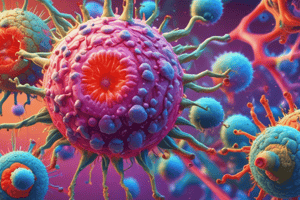Podcast
Questions and Answers
What is an example of an adaptation resulting from a mutation?
What is an example of an adaptation resulting from a mutation?
- The ability to breathe underwater
- The ability to see through walls
- The ability to fly without wings
- The ability to digest lactose (correct)
Which of the following is an example of a beneficial mutation resulting in a more adaptive phenotype?
Which of the following is an example of a beneficial mutation resulting in a more adaptive phenotype?
- The ASGR1 gene mutation (correct)
- Mutations in the PCSK9 gene
- Mutations resulting in lactose intolerance
- The CCR5-∆32 mutation
Which of the following statements about CCR5-∆32 mutation is true?
Which of the following statements about CCR5-∆32 mutation is true?
- It plays no role in the body's inflammatory responses to infections
- It results in a protein that can be detected on the cell surface
- It is more common in African populations
- People with two alleles for CCR5-∆32 are highly resistant to HIV-1 infections (correct)
What happens to less adaptive phenotypes resulting from mutations?
What happens to less adaptive phenotypes resulting from mutations?
What is the benefit of the ASGR1 gene mutation?
What is the benefit of the ASGR1 gene mutation?
What is the PCSK9 gene mutation being studied for?
What is the PCSK9 gene mutation being studied for?
What is the CCR5-∆32 mutation?
What is the CCR5-∆32 mutation?
What is the role of CCR5 in the body?
What is the role of CCR5 in the body?
Which population has a greater distribution of the CCR5-∆32 mutation?
Which population has a greater distribution of the CCR5-∆32 mutation?
Flashcards are hidden until you start studying
Study Notes
- Mutations can result in less or more adaptive phenotypes.
- Less adaptive phenotypes are selected against by natural selection.
- The ability to digest lactose is an example of an adaptation resulting from a mutation.
- Some mutations, like the ASGR1 gene mutation, can result in more beneficial selection.
- People with the mutated ASGR1 gene have lower levels of cholesterol and a lower chance of developing arteriosclerosis.
- Mutations in the PCSK9 gene are also being studied for the development of cholesterol-lowering medications.
- The CCR5-∆32 mutation results in a protein that cannot be detected on the cell surface.
- People with two alleles for CCR5-∆32 are highly resistant to HIV-1 infections.
- The distribution of CCR5-∆32 is greater in European populations, possibly due to selection from other illnesses.
- CCR5 plays a role in the body's inflammatory responses to infections and is involved in the infection process of HIV-1.
Studying That Suits You
Use AI to generate personalized quizzes and flashcards to suit your learning preferences.




